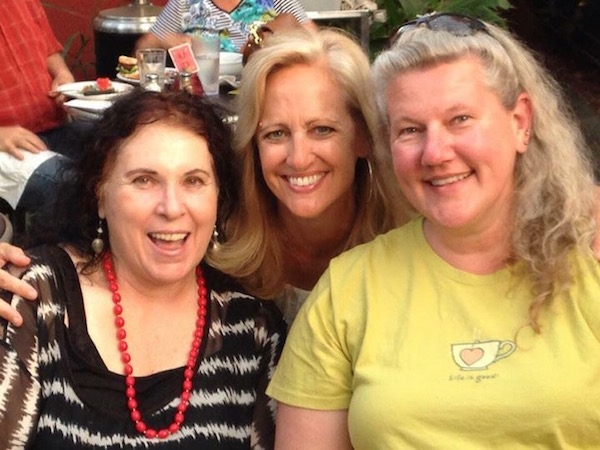
Every second, two people die.
It will happen to us. And to everyone we know and love. Just reading that line can be terrifying.
We’d rather take a drink or check our phones or run a marathon than think about it.
Many people don’t think about death until they have to—until it’s staring them in the face in the form of their own illness or loss, or that of a loved one.
I’ve been extremely fortunate to have two dear friends who, in the midst of vital lives, thought a lot about dying. My longtime friend Ellen spent years exploring death and the spirit through spiritual teachers. My former professor and mentor, Gabriele, contemplated mortality through the lens of literature and art.
“I’ve been interested in the act of dying for years,” said Gabriele. “And I think most people want to run away from it. But I’ve decided I want to look at it head on: what’s involved, what makes it easier, what it is.”
When both women fell terminally ill from cancer (Gabriele a few years ago, Ellen earlier this year), they died as they lived: full of intelligence and curiosity about life/death.
They died with eyes wide open.
They shared this mindfulness with their family and friends so that we could come to, as Judith Orloff says, “…cultivate humility for the elegance of the birth-death cycle.” They helped me to think about how I’d like to approach my own dying—and living.
What a gift.
Gabriele said she was “determined to be a participant” in her act of dying and that “dying is somehow equally as significant and important as birthing.” She looked at “birth and death not as opposites but as the ends of a single continuum.” A teacher to the end, she said she was trying to determine what this view of mortality might mean for her and “for other people who need to learn.”
Likewise, Ellen said on a Facebook post:
As soon as I realized what was happening, I understood it to be good. It’s time. This is my next step, and I want to take it. I’m not afraid of it. I know the moment of passing over will be a moment of great relief and ecstasy. Not all people go easily, but hospice has eased my mind on this score—they say contrary to popular belief, most people die easily at the end. Not all, but most.
The body knows how to die. This is a natural process, and we are fully prepared for it. We don’t have to worry as it approaches. So good to know! That’s the only part that worried me, that it would be hard to let go of my body. Now I believe it will happen without struggle.
Gabriele turned to her beloved poets. She didn’t ascribe to Dylan Thomas’ “rage, rage against the dying of the light.”
Rage blinds. Instead, she took sustenance from Mary Oliver:
When it’s over, I want to say all my life
I was a bride married to amazement.
I was the bridegroom, taking the world into my arms.
Ellen’s spiritual teachers guided her. She wrote on Facebook: “Seth says, ‘You’re as dead now as you’ll ever be.’ Why can’t the ‘living’ feel that?”
Another of Ellen’s teachers was a boyfriend who’d died: “He was ready to go and not afraid. After a couple weeks of fading, he reached the end. When the death rattle came and his body became completely still, the room was suddenly filled with joy! I felt him bigger than ever, and free! It was quite beautiful.”
While Ellen used Facebook as her means of sharing her journey, Gabriele spoke to her daughter, who posted her mom’s thoughts on her blog.
On the blog, Gabriele was quoted as saying: “I’ve been thinking about what life is for, anyway. In the end, we die. I have this gut feeling that we are meant to learn things from life that we don’t know yet—and that everything every human being learns is never lost, but becomes part of the essence of what it means to be human—to be alive in a universe that’s a big unknown. I think that is the immaterial quality of life which never dies, though the body dies, and is recycled and made part of the earth again.”
Gabriele was extremely close to her daughters—her biological ones, and the hundreds of other women she mentored, like me. In the midst of our mourning, Gabriele said that sadness was appropriate—but that we should also feel joy. Her dying journey was revealing profound levels of understanding about the mysteries of life.
Dying, she said, is a grand adventure.
At home under hospice care, Ellen also acknowledged her loved ones, writing on Facebook: “I understand sorrow and grief will be a natural reaction, but please know that there’s no need to feel any on my behalf. I am excited!”
With her family, Ellen wrote her obituary, saying “That was fun! Really! I’ve lived an adventurous life…My family understands what’s happening, and they are making the most of our time together…Thank you all for being in my life!”
This amazing and generous post generated hundreds of responses. Her friends and family shared memories, pictures, and appreciations on her page.
Later, on the phone, Ellen told me she felt like she was getting the chance to attend her own funeral online. She cherished the outpouring of love and appreciation—things she might not have heard otherwise.
This, however, is not the end of the story. Ellen would occasionally post things that had nothing to do with dying (political concerns, videos of random acts of kindness, photos of her and her family watching a baseball game on TV), demonstrating that dying does not have to be one’s only focus, even while on hospice.
When I went to visit Gabriele two weeks before she died, we talked about all kinds of things and laughed a lot. Then she held me, for a very long time, and stroked my hair. If she had been ashamed or in denial or fearful, we never would have had that chance to express our love.
Because I’m in China, I can’t visit Ellen in California. But I valued her Facebook updates, such as: “This has been a good week for me. My sister is visiting.” Or “I can barely stay awake these days. And when I am awake, I am so happy…In such ardent love with everyone.”
She wrote about two friends giving her a pedicure, painting her toenails a pink, sparkly color so she had “something fun to look at” while in bed. Humorously, she wrote about how sometimes the pain medications would make her confused—she tried to sip water from her phone and couldn’t understand why it didn’t work!
Not that either of these women never felt fear. They were honest when it arose. And then, because of all the exploration they’d done of death, they were able to shift from fear into curiosity and wonder.
Ellen wrote about how she woke in the middle of the night, feeling alone and in pain. She called hospice, which soothed her. With hospice workers, she and her family talked about what her dying might look like.
“No one can predict what will happen or when,” she wrote. “The scariest would be a hemorrhage, due to all the blood. So hospice in their wisdom gathered my family caregivers in my room last Friday and explained what to do if this happens. It was very helpful, and furthermore it gave the group more cohesion, more of a team feeling.”
Gabriele had good reasons to soften her fear: “We humans are still at a stage at which we really don’t know what to think about death, and fear really interferes with how we’re able to see it.”
They both wanted to see it, this divine transformation.
And to help us see it, too.
Author: Kate Evans
Image: Author’s own
Editor: Renée Picard






Read 36 comments and reply